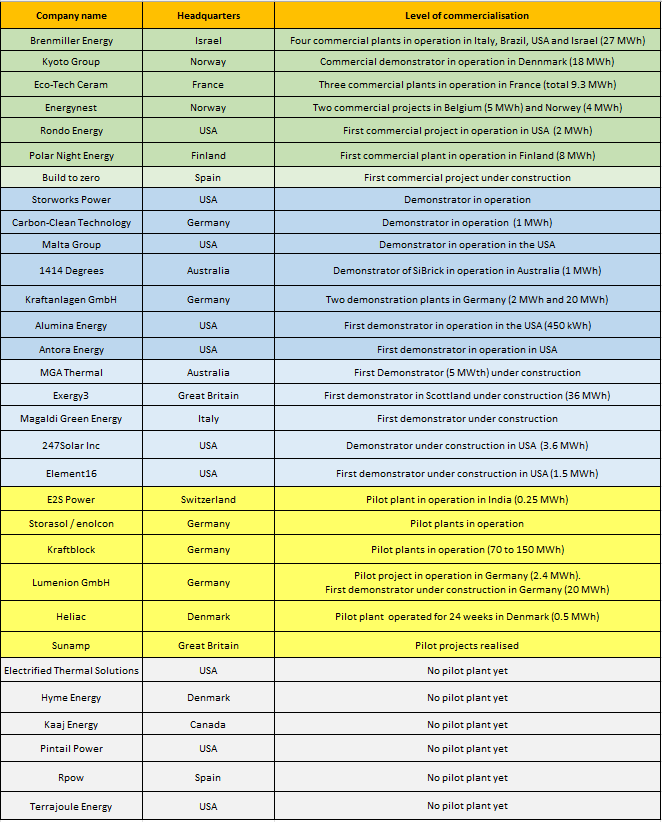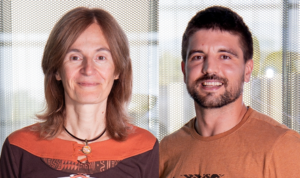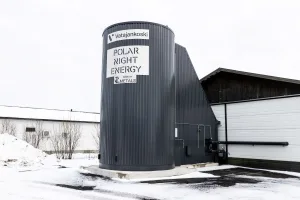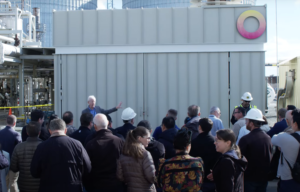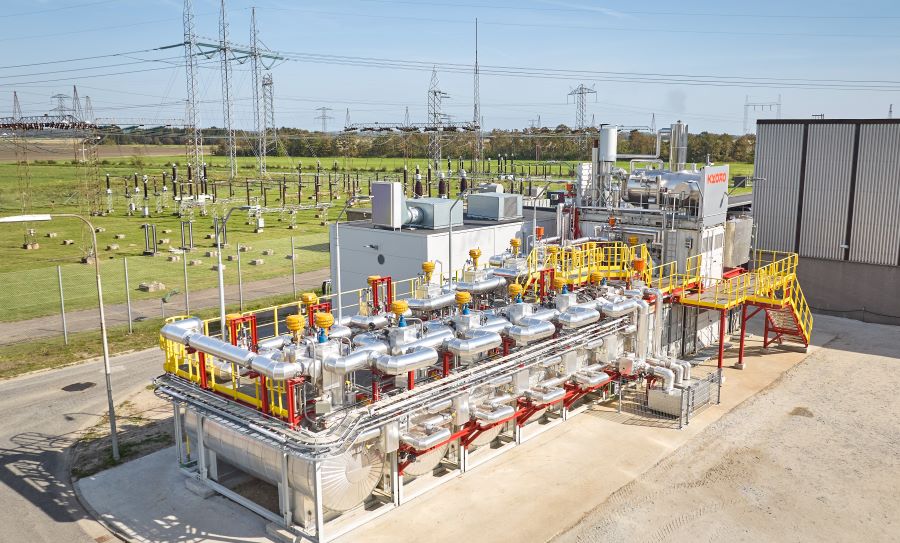
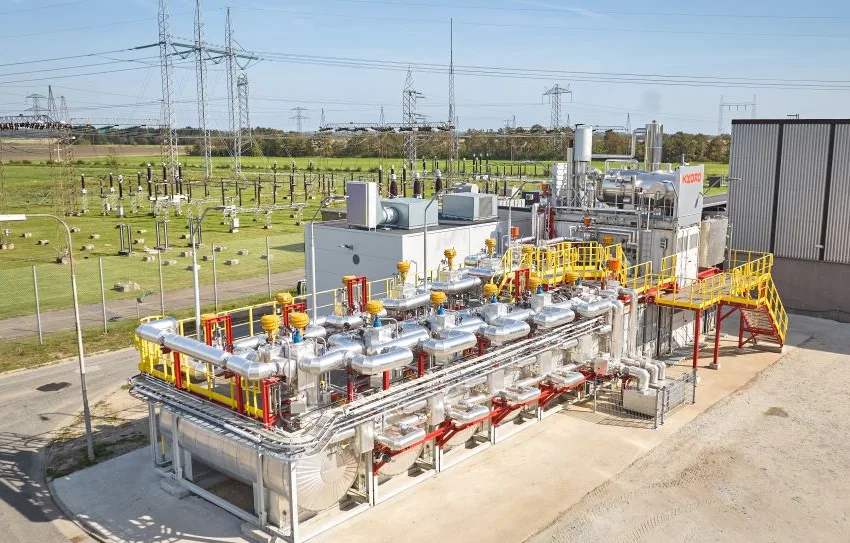
Worldwide overview of high-temperature energy storage system providers
High-temperature thermal energy storage is one important pillar for the energy transition in the industrial sector. These technologies make it possible to provide heat from concentrating solar thermal systems during periods of low solar availability including overnight, or store surplus electricity from the grid using power-to-heat solutions and provide heat to industrial clients. Some solutions even allow energy storage at temperatures around 2,000 °C – hot enough to address “hard-to-decarbonize” sectors like cement and steel. These business opportunities seem to be very attractive. The number of high-temperature storage providers is constantly increasing, and they are raising enormous amounts of venture capital and subsidies. We have identified more than 30 companies mostly startups in this segment. 31 companies from 12 countries took part in a survey and reported details about their technology, their customer groups, and the TRL of their products. We paid particular attention to the level of commercialization and wanted to find out how many commercial high-temperature storage units of the new generation are already in operation. The market survey was financed by Natural Resources Canada. The results are available as PDF table.
Photo: Kyoto Group
One can really speak of a “new generation” of high-temperature storage solution providers. If you take out the two established companies in plant engineering, Kraftanlagen (founded in 1923) and Magaldi Group (founded in 1929), then the 29 remaining companies are on average only nine years old.
How do we define high temperature in this survey? The listed products store heat at between 300 and 2,400 °C.
Obviously, high temperature storage is not a new technology. It has been used and deployed in concentrating solar power plants around the world in the form of molten salt since the 1980’s. Even before that, steelworks have been using so called regenerators in the form of ceramic bricks charged by gas furnaces. What is new is the business case: the need for decarbonizing high-temperature industrial heat in a wide range of applications.
Industrial heat is a new business case
This is what the new generation of high-temperature storage providers is targeting. 28 companies list the industry sector as one key customer group, 11 of which offer their products exclusively to industrial customers. The exception are the three companies that only target the power plant sector (E2S Power, Switzerland) and the electricity sector (Kraftanlagen, Germany, and Pintail Power, USA).
Two companies stand out from the large pool of firms by offering heat as a service: Rondo Energy (USA) and Kaaj Energy (Canada). You can find the target customers of the respective storage manufacturer in the attached overview table in the fourth column “Providing storage solutions to which sector”.
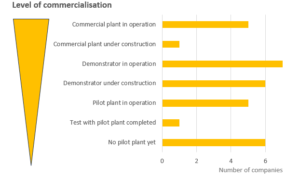
31 storage solution providers sorted by their level of commercialization
Source: solrico industry survey February 2024, companies’ information
Six companies have realized commercial plants
An important part of the survey was determining the “level of commercialization”. The most advanced installed plants are mentioned in the following table including pilot systems, first demonstrators, or commercial systems. Only systems that are already in operation or under construction are included in the table; announcements of planned demonstrators or commercial facilities were not considered.
The six companies that have already implemented commercial systems are highlighted in green in the following table. Detailed descriptions about the systems can be found in four separated news articles: Energynest and Kyoto Group (Norway), Polar Night Energy (Finland), Rondo Energy (USA) and Brenmiller (Israel) and Eco-Tech Ceram (France).
31 high-temperature energy storage system providers sorted by level of commercialization. The complete data of the company overview can be found in this PDF table.
Source: solrico industry survey February 2024, companies’ information
Specification of storage capacities is a critical metric
A critical point in the table above is the storage capacity information in megawatt hours for commercial or demonstrator plants. There is no standardized method to calculate the heat capacity of a high-temperature storage system and therefore numbers reported by each provider may be inconsistent or vary based on what calculation has been used.
Annelies Vandersickel, Head of the Department Thermal Process Technology at the German Aerospace Institute, defined the difference between maximum and usable storage capacity in an interview with solarthermalworld. The maximum storage capacity is the thermal energy that can be stored in the storage material according to its heat storage capacity when fully loaded referring to the difference between maximum storage temperature and ambient temperature. The usable capacity takes into account the customer’s demand of heat. For example, if steam is required at 300 °C, then the storage can only be discharged to 310 °C. There is correspondingly less usable storage capacity available. We assume that the companies have reported maximum storage capacities for their projects when taking part in the survey.
Industry hub in the USA and Europe
The USA is the clear frontrunner with its ten high-temperature storage providers of the new generation (see pie chart below). This certainly has something to do with the lavish funding by Department of Energy and other sources in the USA. But US companies are also very successful when it comes to raising venture capital.
For example, in February the Thermal Battery maker Antora Energy announced that it raised USD 150 million in a funding round led by a tie-up between Blackrock and Singapore state investment firm Temasek. Rondo Energy – also based in California – has raised already USD 82 million to date according to company´s information.
If you add the European manufacturers together, there are at least 17 companies, more than half of the overview. Germany tops the list with five firms and two each are in Norway, Great Britain, and Denmark.
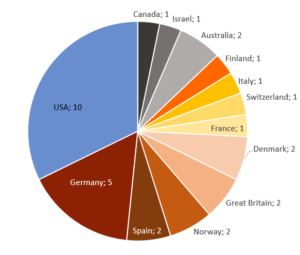
31 high-temperature storage providers listed according to their headquarters. The overview largely covers the new generation. However, three companies are not included in the overview, even though they supposedly offer high-temperature storage solutions: Graphite Energy from Australia did not want to take part in the survey. No contact could be made with Stiesdal Storage in Denmark and Fourth Power in the USA. Source: solrico industry survey February 2024
Wide range of storage materials are used
An interesting part of the survey was the description of the storage technology used. We have crosschecked with all companies the features of their products as listed in the overview table (see pdf for download below). There is a wide range of technologies that depend on the desired temperature level.
Below 300 °C you find storage types which are pressurized, water-filled vessels. However, there is only one company offering such solutions in the overview (Terrajoule Energy, USA). As design temperatures increase to between 300 and 565 °C, molten salt is employed as the storage medium. Six companies in the overview use this technology: Build to zero (USA), Hyme Energy (Denmark), Kyoto Group (Norway), Malta Group (USA), Pintail Power (USA), and Rpow (Spain). Above this temperature range molten salt becomes corrosive to stainless steel. An exception here is the Danish company Hyme Energy which claims to develop a molten salt storage solution that can be operated at maximum 700 °C.
The majority of the companies target heat storage at temperatures above 565 °C and therefore use solid materials. 18 companies fall into this category, which can be divided into two groups. Those companies that use a real solid such as graphite or concrete blocks, bricks, cement tubes, granite rocks or even steel rods – 12 companies altogether. The other eight companies rely on a variety of smaller-sized solids: sand, gravel, stones, ceramic balls, crushed volcanic or rocks.
The three companies that use phase change materials occupy a special position. Compared to sensible storage more energy can be stored per unit volume through a phase transition, usually a melting process. These are the companies: 1414 Degrees (Australia), Sunamp (Great Britain) and MGA Thermal (Australia).
“Power-to-power via a heat storage is not a real business case”
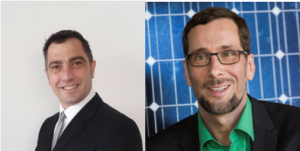
Two solar energy experts: Toni Fersini, Owner of the Spanish consultancy Fersisolar (left) and Volker Quaschning, Professor for the field of renewable energy systems at the HTW Berlin University of Applied Sciences in Germany Photos: private
The crucial question is now the long-term business case for such high-temperature energy storage system providers. We asked two experts and publish their statements:
Toni Fersini: “Thermal storage will undoubtedly be the main protagonist in 2024. I also believe that both concentrating solar power and solar industrial heat make sense only if accompanied by a reliable thermal storage system. However, the high prices of some solutions are often compared with systems currently available through fossil fuels. Therefore, solutions that operate at lower temperatures will be the first to be implemented in industries on a massive scale. As the costs of fossil fuels rise, and emission rights to industries increase, technologies that can provide higher temperatures will be installed in industries. This is assuming there are no exclusive incentives for this sector.”
Volker Quaschning: “In my opinion, power-to-power via a heat storage is not a real business case because the round trip efficiency is too low. Prices of electric batteries will certainly fall again by a factor of 2 or 3, so it is better to store electricity directly.
The business case of power-to-heat solutions for industry depends very much on the development of electricity prices. For example, when the last lignite-fired power plants in Germany go offline in 2030, there will be phases with really expensive electricity. Then these storage devices fully exploit their function as a flexibility asset in combination with an electric boiler for example. However, the operating temperature of the storages must be adjusted to suit requirements. A storage that is charged to over 1,000 °C to provide 200 °C steam will have nothing left in it after two or three weeks of storage, if it is not really heavily insulated. High-temperature storage makes sense especially where there is a space problem because they have a high storage density.”
Websites of companies mentioned in this news article:
Alumina Energy: https://www.aluminaenergy.com/
Antora Energy: https://antoraenergy.com/
Brenmiller Energy: https:///www.bren-energy.com/
Build to zero: https://buildtozero.es/
Carbon-Clean Technology: http://www.carbonclean.de/
E2S Power: https://e2s-power.com/
Eco-Tech Ceram: https://ecotechceram.com/en/
Electrified Thermal Solutions: https://electrifiedthermal.com/
Element16: https://element16.com/
Energynest: https://energy-nest.com/
Exergy3 : https://www.exergy3.com/
Heliac: https://heliac.dk/solutions/rockstore/
Hyme Energy: https://www.hyme.energy/
Kaaj Energy: https://kaajenergy.com/
Kraftanlagen: https://www.kraftanlagen.com/en/solutions/energy/green-heat-module/
Kraftblock: https://kraftblock.com/de/
Kyoto Group: https://www.kyotogroup.no/
Lumenion: https://lumenion.com/
Magaldi Green Energy: https://www.magaldigreenenergy.com/en
Malta Group: https://www.maltainc.com/
MGA Thermal: https://www.mgathermal.com/
Pintail Power: https://www.pintailpower.com/
Polar Night Energy: https://polarnightenergy.fi/
Rondo Energy: https://rondo.com/
Rpow: http://www.rpow.es
Solstor Energy: http://www.solstor.energy
Storasol / enolcon: https://storasol.com/
Storworks Power: https://www.storworks.com/
Sunamp: https://sunamp.com/
Terrajoule Energy: https://www.terrajoule.energy/
1414 Degrees: https://1414degrees.com.au/
247Solar Inc: https://247solar.com/
